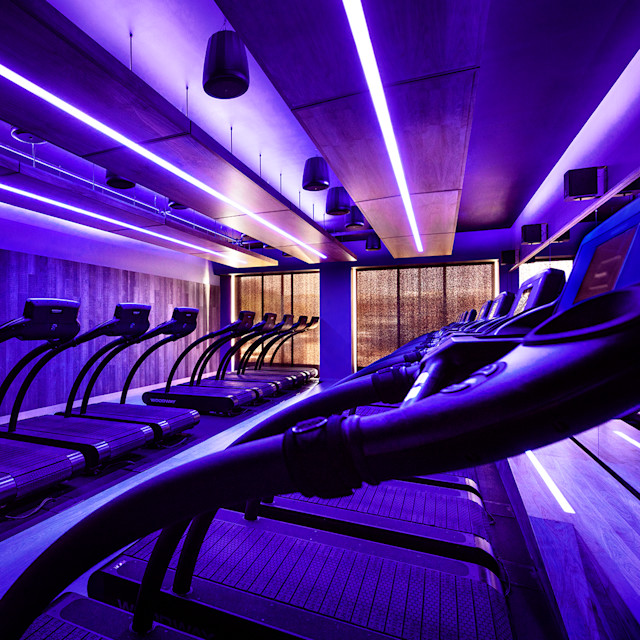A Precision Run coach breaks down the biomechanics of running on a treadmill.
When summer comes along, your window to squeeze in a run outside narrows. Unless you get out the door before sunrise or after sunset, you’ll be in for a sweaty, humid, grueling workout. That’s why June, July, and August are perfect for embracing the treadmill life.
There’s a lot to love about treadmill workouts. Besides helping you escape the heat, Precision Run coach Cooper Mann points out that the machine allows you to customize your run so you can work on your weaknesses and grow as a runner yourself. “A treadmill lets you be able to control your speed and incline,” says Mann. “You get to set what pace and incline you want. If you are feeling really good, maybe you decide to challenge yourself with a pace or incline you've not tried before or held as long.”
Treadmills also allow you to measure your running in minutes instead of miles, which can be especially helpful for beginner runners. “Those who are new to running can set small amounts of time [on the treadmill] and gradually build up, starting with 5 minutes and slowly adding more time or noting how much distance you covered in 5 minutes,” he says.
While running on the treadmill is a near-perfect substitute for hitting the trails or streets, you need to remember a few things when you opt to stay in the air conditioning for today’s workout. Below, Mann goes over how logging your miles on the tread differs from pounding the pavement and a few fast and fun Precision-style workouts to help you maximize your time running in place.
The Biomechanics of the Treadmill
According to Mann, running on the treadmill differs from running outside for a few key reasons. “On a treadmill, the tread will stay at a constant speed, and the runner needs to keep their legs turning over fast enough to match it,” Mann says. “Outside, the runner has to propel themselves forward to be able to keep pace.”
As a result, research shows that the muscles work a little less while you’re running on the treadmill. And thus, you’ll have to intentionally engage major muscle groups that you wouldn’t necessarily need to think about outdoors. “When running on a treadmill, people often use their hip flexors and back to help move their legs. But if they stay mindful of their body, they can easily engage their glutes (butt), hamstrings, and trunk,” explains Mann.
As for that age-old myth that you have to push the treadmill up to a one percent incline to simulate wind, Cooper says that’s not quite true. “It isn't enough to help change the skill or intensity much,” he explains. “But it does help aid in creating more of a caloric burn. Outdoor running will require a slightly higher caloric burn due to wind resistance, hills, and changes in terrain.”
You’ll have to mess with the machine’s speed and incline to challenge your body. “Inclines on the treadmill are a great way to practice form and develop your posterior strength,” says Mann. “Most people don't like hills. They aren't fun! They aren't comfortable, but they are great for helping develop strength, speed, and increased caloric burn.”
If you’re hoping to squeeze in a treadmill workout today, Mann has a few tips to help you transform your next indoor run into a rigorous, fun exercise.
3 Tips for Making the Most of Your Treadmill Workouts
1. Pay attention to incline instead of distance
Most of us have walked up to a treadmill with the goal of walking or running X miles, but Mann wants you to shake things up. “One of my favorite things to do on a treadmill is to set a goal of how much vertical distance I want to cover,” he says. “Instead of focusing on how far I want to go, I like to see how high I can climb. It might be 200 feet. It might be 1000 feet. Maybe more.”
2. Walk hills
If you’re not in the mood to pick up the pace today and run those hills, Mann says a nice walk uphill will shake things up. “Using the treadmill for a steep incline walk is a great way to get in shape. Find a speed and incline that lets you safely walk on the treadmill without holding on,” he says. “You'll sweat and see your heart rate increase. This is the conditioning that can help improve cardio fitness, fat efficiency, and strength. Plus, it is less impact on your joints.” Turn on a show or listen to a podcast; before you know it, you’ll have hiked a mountain.
3. Try a Precision Run class
“People often dread running on the treadmill. It can be very boring. But participating in a class like Precision Run breaks it up into intervals. You run for a bit and then recover. The effort starts easy to moderate and gradually builds. And it's all based on what that particular individual feels they are capable of doing,” says Mann. Find a Precision Run class at a Club near you or on Equinox+.
